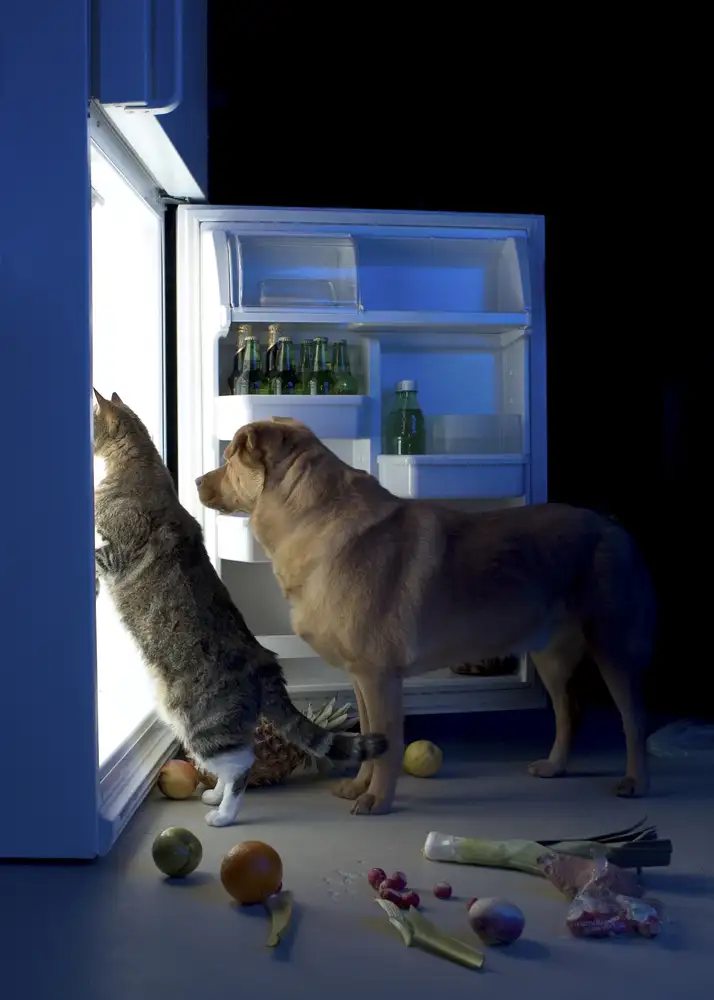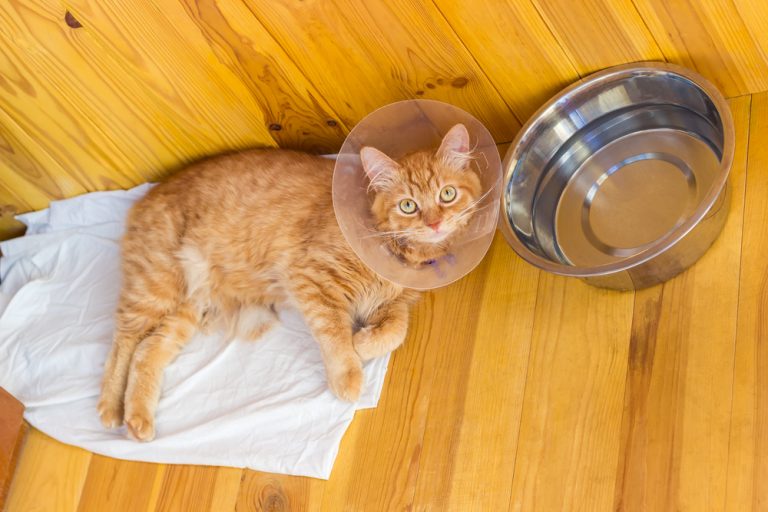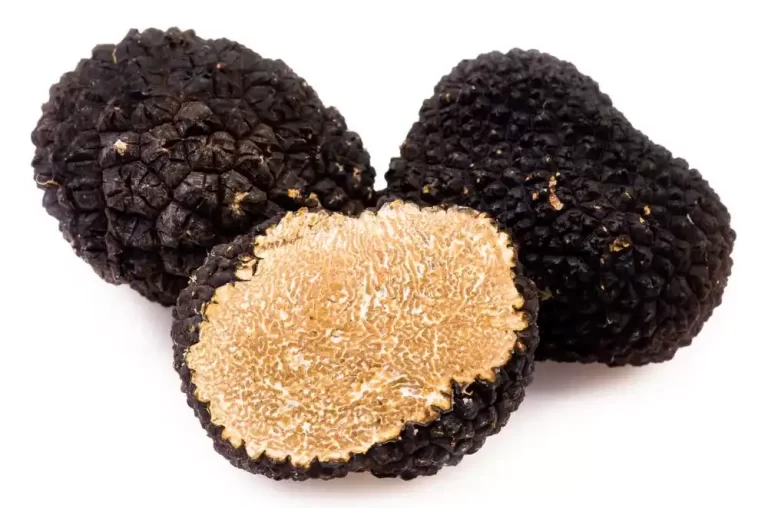Cat Ate Styrofoam: 7 Tips for Preventing Your Cat from Eating Foam Packaging
You’re probably here because your cate ate some Styrofoam. Well, if your cat is as curious as mine, then you are probably always looking for ways to keep them safe. Now, cats love trying out new things and will eat whatever they like even if it’s not healthy for them.
I did a comprehensive research on why cats eat styrofoam and here is what I found.
- Why is My Cat Eating a Styrofoam Food Container?
- What Happens If my Cat ate Styrofoam?
- Will Stomach Acid Dissolve Styrofoam?
- Can Cats Digest Styrofoam?
- What are the dangers of Styrofoam for cats?
- What to Do If Your Cat Ate a Small Piece of Styrofoam
- Tips for Preventing Your Cat from Eating Foam Packaging
- 1. Avoid Leaving Foam Packaging Around the House
- 2. Discourage Your Catto from Playing with Foam
- 3. Make Sure Your Cat Has Plenty of Food and Water at All Times
- 4. Make Sure Your Cat Has Plenty of Toys to Play With
- 5. Talk to Your Vet/Animal Behaviorist about Ways to Help Prevent Foam Consumption
- 6. Clean up Any Foam That Your Cat Spits Out
- 7. Make Sure Your Cat Is Absorbing Enough Nutrients
- Are Styrofoam Peanuts Toxic to Cats?
- FAQ
- Why Do Cats Like Sponges?
- Should I Take My Cat to the Vet If They Ate Styrofoam?
- What Are the Signs That My Cat Has Eaten Styrofoam?
- Is Styrofoam Toxic to Cats?
- Are There Any Home Remedies I Can Use If My Cat Eats Styrofoam?
- Is There a Risk of My Cat Getting an Intestinal Blockage If They Ate Styrofoam?
- How Long Does It Take to Pass a Blockage?
- How Can I Tell If My Cat Is Having Difficulty Digesting the Styrofoam?
- What Advice Would a Veterinarian Give If My Cat Ate a Small Piece of Styrofoam?
- Why Is My Cat Eating Styrofoam?
Why is My Cat Eating a Styrofoam Food Container?
The most obvious reason why cats might feel the need to eat styrofoam is that the material was used as food packaging and your cat can still smell the alluring scent of food on it.
This satisfies their need to bite and use their claws, as well as providing an ideal material for sharpening their claws.
What Happens If my Cat ate Styrofoam?
If a cat eats styrofoam, it can lead to a blockage in the stomach or intestines. This can cause symptoms such as vomiting and diarrhea, as well as be life-threatening if not treated promptly.
If a cat accidentally inhales a small piece of styrofoam, it could get stuck in their airway and stop them from breathing which could prove fatal.
A blood test may also be recommended by your vet just to be sure no toxic effects are present from large quantities consumed.
Will Stomach Acid Dissolve Styrofoam?
Stomach acid is not capable of dissolving styrofoam. However, when ingested, the majority of styrofoam fragments are small enough to travel through the GI system without creating issues.
This is why it is important to check your cat’s stool for signs of the foam material in order to ensure its safe passage through the digestive tract. According to the MIssouri Poison Center, styrofoam does not get absorbed into the body.
Can Cats Digest Styrofoam?
Cats CANNOT digest styrofoam. Most are made of plastic that any body, leave alone a cat’s, can’t digest. However, some packaging like peanuts are made from corn starch foam which is not so toxic to cats.
Cats can comfortably eat corn without any issues. I’ve prepared a blog post discussing on which cats should and shouldn’t eat corn and how to feed corn to cats. You can check out this cool article on why cats should eat corn.

What are the dangers of Styrofoam for cats?
1. Styrofoam May Cause Nausea and Vomiting
The symptoms of Styrofoam ingestion in cats include nausea, vomiting, abdominal pain, lack of appetite, lethargy or fatigue, and difficulty breathing or panting.
In severe cases of ingestion, the cat may have seizures or become unconscious. If the blockage is not removed quickly enough it can lead to death by suffocation.
2. May Cause Stomach Ulcers
When ingested, Styrofoam does not break down or enter the cat’s body. The majority of styrofoam fragments are small enough to travel through the GI system without causing issues.
However, when exposed to heat (eg when microwaved), styrofoam degrades into hazardous compounds that can cause long-term damage to a cat’s stomach including stomach ulcers.
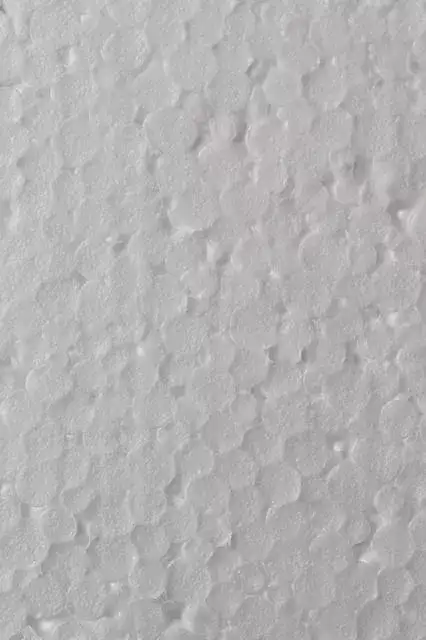
3. May Cause Toxicity
The chemical styrene present in Styrofoam is an irritant and can cause mild irritation to the mouth and gut if ingested by cats.
In extreme cases, prolonged exposure to styrene may lead to more serious health problems such as neurological issues or liver damage.
4. May Cause an Obstruction in the Digestive Tract
The effect of styrofoam on the digestive tract of cats is that it can cause blockages in the gastrointestinal tract, airways, and other organs.
If the styrofoam blocks the intestines, your cat may experience constipation or vomiting/diarrhea (when it’s partial).
Other symptoms include weakness, lack of appetite, and abdominal pain. If it causes a complete blockage of the intestines, there could be severe consequences such as bacteria spreading through the organs or ruptures/deaths in parts of them.
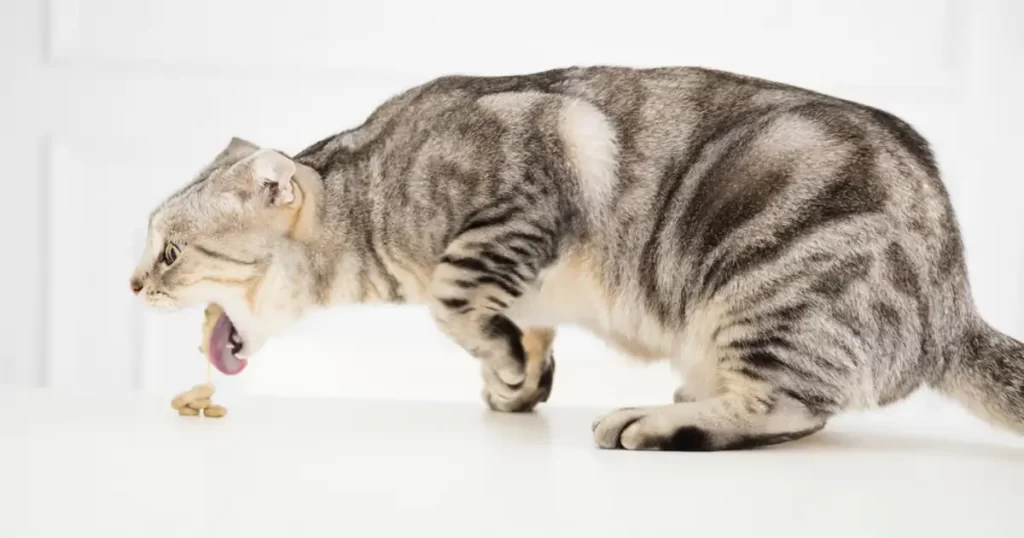
5. Can Cause Choking
Inhaling or swallowing pieces of Styrofoam can obstruct a cat’s airway, causing them to choke.
This can be life-threatening and requires immediate veterinary attention in order to give the cat the best chance of survival. Oxygen will be administered and the blockage will be removed as quickly as possible.
6. May Cause an Allergic Reaction
As with anything else, some cats can have a severe allergic reaction to styrofoam. Some symptoms of an allergy include swollen sensitive paws, runny nose, diarrhea/vomiting and watery eyes.
7. Styrofoam May Cause Kidney Failure
Eating styrofoam can be toxic for the kidneys of cats. The material is made up of harmful chemicals (Styrene) that can affect the kidney and other internal organs.
A veterinarian may be able to detect any damage through medical examinations, but it is important to prevent your cat from eating it regularly even if they don’t show any symptoms after each time they ingest it.
The regular ingestion of styrofoam can lead to adverse effects on the liver and kidneys, as well as an increased risk of cancer. This leads me to the next point.
8. Styrofoam May Cause Cancer
Styrofoam is harmful to cats’ health. The starch in peanuts is non-toxic and biodegradable, which makes them safe for people and pets if consumed unintentionally.
However, ingesting styrofoam regularly can lead to cancer in cats which has a poor prognosis and usually results in death within a few months of diagnosis.
What to Do If Your Cat Ate a Small Piece of Styrofoam
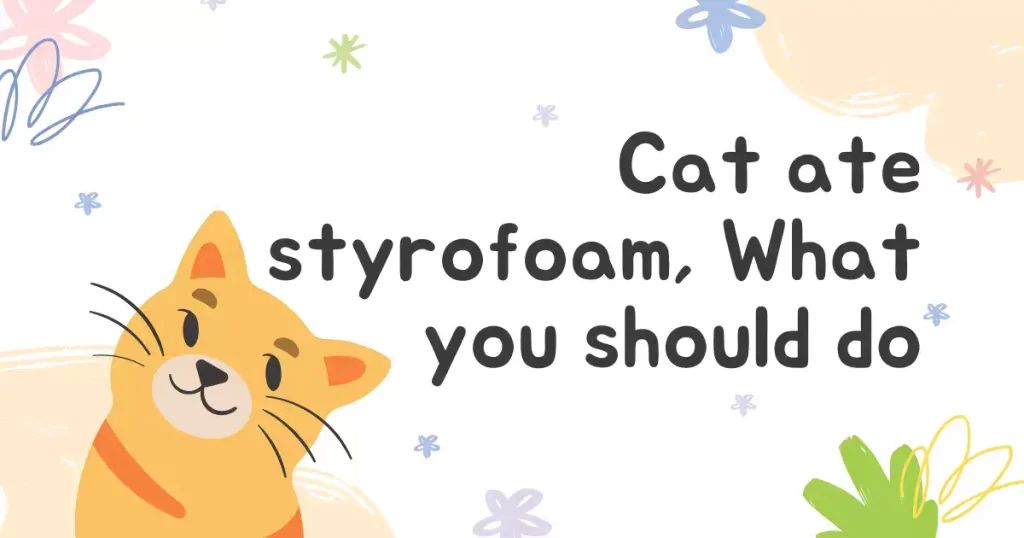
Step 1: Check Your Cat
If your cat is not breathing normally, check to see if their mouth is open and the tongue is out. This may mean they have choked on a piece of styrofoam. If you find pieces of styrofoam in your cat’s mouth or stomach area, take them to the vet as soon as possible for treatment.
Be aware that cats may become very agitated and attempt to bite. Be careful when handling them!
Watch for any signs that your cat has been poisoned by styrofoam – such as vomiting, diarrhea or unusual behaviors (such as running around erratically).
Step 2: Prevent Access to More Styrofoam
Keep an eye on your cat and make sure they don’t have access to any more styrofoam. You should also keep an eye out for any other pets in the house, as they could also be attracted to the smell of the foam.
If necessary, block off areas where there may be pieces of styrofoam lying around so that cats can’t get to them easily.
Try distracting your cat with toys or treats so that they no longer have an interest in eating the foam anymore!
Step 3: Call Your Veterinarian
Call your veterinarian for advice as soon as possible. Tell them when and how much styrofoam your cat ate, as well as any other relevant information such as any signs of problems with vomiting or breathing.
If you suspect that your cat has ingested styrofoam, contact your veterinarian or Pet Poison Helpline for advice on how to handle the situation safely and quickly (1-800-213-6680).
Get an imaging or diagnostic test, if necessary. Your vet may recommend an imaging test such as an X-ray or CT scan to determine the extent of damage caused by the styrofoam ingestion and locate any remaining pieces that could cause further problems if left untreated.
Your vet will be able to advise you on the next steps based on this information, which may include bringing your catto into the clinic for an examination, further diagnostic tests, and treatment or simply monitoring them at home if they think it is likely to pass without complications.
Step 4: Follow Your Vet’s Advice
Decide on a course of action based on their recommendation and budget constraints. Depending on the severity of the case, your veterinarian may advise you to monitor your cat at home or suggest more intensive treatments such as surgery or IV fluids for hydration purposes.
Additionally, they should be able to provide you with information regarding any associated costs so that you can make an informed decision about what is best for your pet’s healthcare plan within your budget constraints.
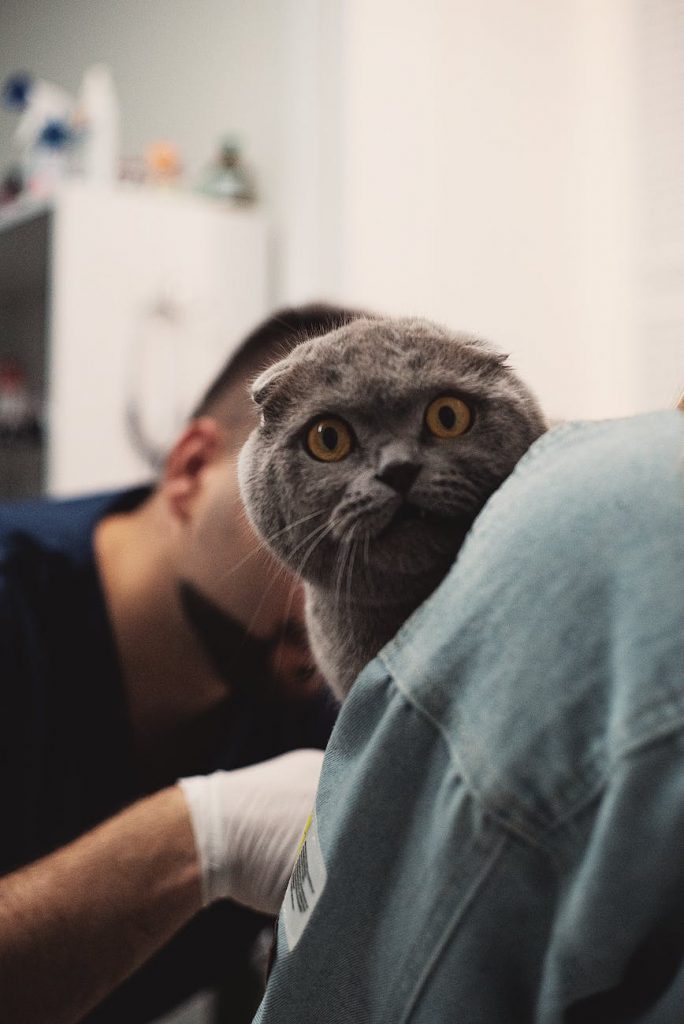
Step 5: Don’t Treat at Home
Monitor your cat’s behavior and look for signs of discomfort or pain. If there are no signs of discomfort, wait 12 hours and monitor your cat’s condition again before deciding whether further action is needed (e.g., inducing vomiting).
If you decide to induce vomiting, do so under the guidance of a veterinarian who will provide an appropriate drug along with dosage instructions for use at home (do not attempt this on your own).
Tips for Preventing Your Cat from Eating Foam Packaging
1. Avoid Leaving Foam Packaging Around the House
Keep an eye out for any foam substance around the house, such as Styrofoam cups or bin bags. If there are other pets in the house, such as pups or rabbits, ensure they are also kept away from the foam packaging to prevent them from eating it as well.
If possible, shut your cat away whilst you clear up any split bin bags so they cannot access them easily when you’re not looking.
2. Discourage Your Catto from Playing with Foam
Monitor your cat’s behavior around foam packaging, and if they appear interested in it (eagerly sniffing or pawing at it), distract them immediately with an alternative toy or reward system such as treats or praise/love words/petting sessions, etc..
If you notice any changes in behavior (eagerness to eat food quickly; lack of interest in playing) then contact a verified vet right away as this may indicate that your cat has eaten some amount of styrofoam which needs medical attention immediately!
3. Make Sure Your Cat Has Plenty of Food and Water at All Times
Make sure there is no styrofoam or plastic packaging near the food or water bowl as this can attract your cat’s attention and cause them to ingest it accidentally.
Regularly clean out any trash cans that may contain foam packaging materials, as these can also attract cats and lead them to ingest more foam.
4. Make Sure Your Cat Has Plenty of Toys to Play With
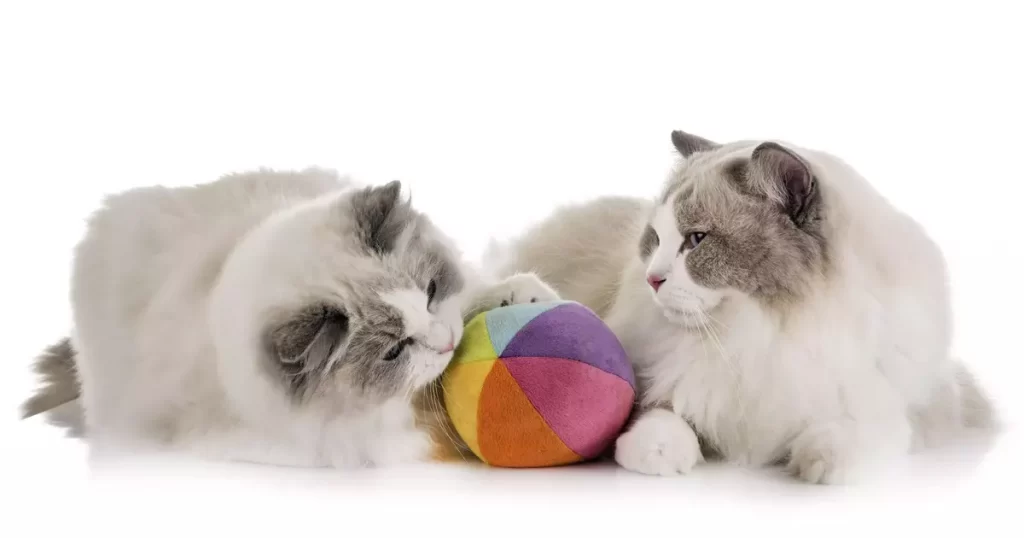
We all get bored and try out new things. Your kitto is no exception. As they try to explore they may end up playing with styrofoam and in the process eating or inhaling it.
This can easily be avoided by giving your cat something else to chew. Offer him other toys and items he can play with instead of the foam packaging.
It doesn’t end there. You can also play with your cat: Engage in interactive games with your cat to keep him entertained and distracted from chewing on foam packaging or other items he shouldn’t be eating.
I love playing with my kitto and my go to game is pulling a string in front of her. She hides behind the seats and pounces on the string as if she’s hunting.
Playing helps keep your kitto busy and releases some of the energy she’d have used to go hunting down some dangerous things, not just styrofoam.
5. Talk to Your Vet/Animal Behaviorist about Ways to Help Prevent Foam Consumption
My go to person is always my vet. If your kitto is always finding ways of eating styrofoam, then you should have a candid talk with a vet or an animal behaviorist.
Is your cat malnourished? Is s/he traumatized? Is your kitto sick? These are some of the things that can help you know why all of a sudden your cat has picked interest in eating a foam.
6. Clean up Any Foam That Your Cat Spits Out
Thoroughly clean all areas where the foam was found using a vacuum cleaner or broom to remove any remnants that may still be present in order to prevent more ingestion by either you or your cat later on down the line..
7. Make Sure Your Cat Is Absorbing Enough Nutrients
One of the reasons your cat may be picking up this weird habit is maybe they are not getting enough nutrients. You need to have a sit down with your vet to get a recommended diet.
Make sure you also read the labels on any cat food you buy and make sure it is high in protein and fat.
Look for canned or pouched varieties of cat food that do not contain foam packaging, as this may tempt your kitto to bite some.
If possible, cook your cat’s food yourself to ensure it contains no additives or preservatives that may affect their health negatively over time.
Make sure there are plenty of clean water sources available for your cat at all times so they can stay hydrated throughout the day.
Are Styrofoam Peanuts Toxic to Cats?
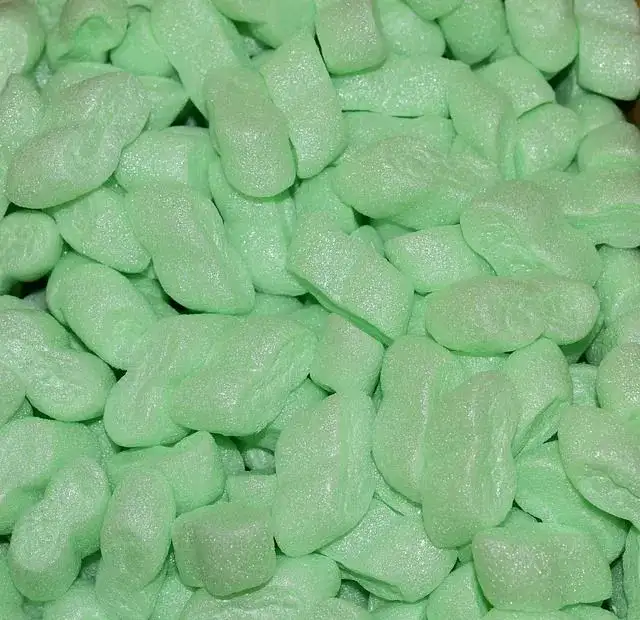
Styrofoam peanuts are toxic to cats. The starch in peanuts is non-toxic and originates from crop-based sources rather than petroleum-based plastics. However, it can still cause cancer in cats if ingested on a regular basis.
Additionally, even though the biodegradable foam peanuts have no electrostatic charge and are safe for people and pets if consumed unintentionally, they still pose a risk of very debilitating diseases or even death in the long run if ingested regularly by your cat.

Cats on a Vegan Diet: Benefits and Feeding Tips
FAQ
Why Do Cats Like Sponges?
Cats like sponges for a variety of reasons. Some cats may have pica, a condition in which they lick, chew, and eat non-food objects. Other cats may be attracted to the texture of the sponge or enjoy playing with it because it bounces around easily.
Cats may also have an instinctive need to recreate what happens in nature when they capture prey by tossing it about before presenting it to their owner. To find out more about Pica, you can check out this cool article by International Cat Care Org.
Don’t worry, many cats, including my own Chacha, are obsessed with sponges, cartons, and boxes.
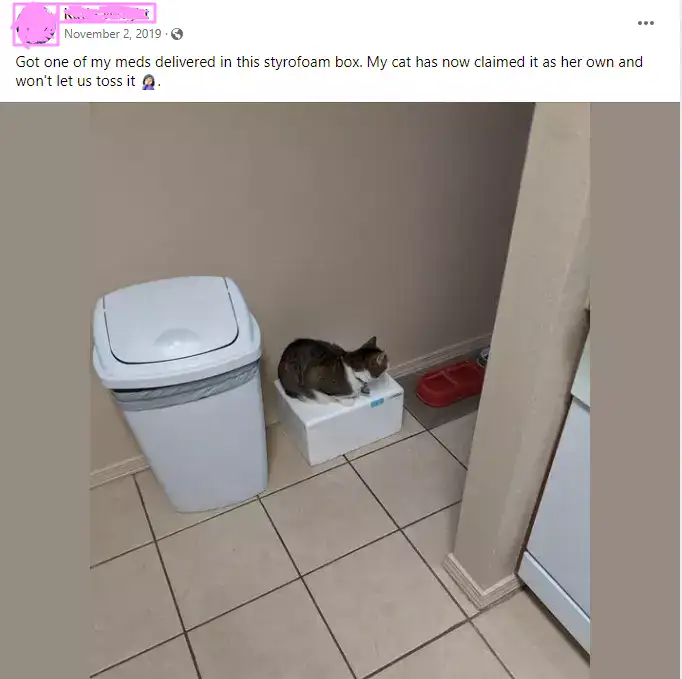
Should I Take My Cat to the Vet If They Ate Styrofoam?
It is not necessary to take your cat to the vet if they ate small amounts of styrofoam that did not cause any discomfort or unusual behavior in 48 hours. However, if symptoms such as vomiting or diarrhea occur then you should seek medical attention immediately. Additionally, if heavy amounts were ingested it is best to contact a veterinarian before taking further action.
What Are the Signs That My Cat Has Eaten Styrofoam?
If your cat has eaten Styrofoam, he may show signs of illness such as:
- Being quieter than usual and more lethargic
- Vomiting
- Diarrhea
- Lack of interest in food and/or water
- Dehydration
If your cat inhales the foam rather than eating it, he may show signs such as:
- Difficulty breathing or panting
- Excessive coughing
- Wheezing
Is Styrofoam Toxic to Cats?
Styrofoam is not immediately toxic to cats. However, it can still make your cat sick if she eats a small piece of shredded Styrofoam. It is also not safe for cats as it is made of plastic that does not easily break down in the environment and can cause internal damage if ingested repeatedly.
Are There Any Home Remedies I Can Use If My Cat Eats Styrofoam?
If your cat eats Styrofoam, there are a few home remedies you can try:
1. Feed your cat spongy foods like tuna with oil or cottage cheese to wrap around the styrofoam and help it pass through their digestive system more easily.
2. Keep an eye on your cat for any unusual behavior or discomfort in the hours following ingestion and contact your veterinarian if necessary.
3. At the earliest sign of discomfort, it’s best to take action and call your vet right away so they can recommend further treatment options if needed (such as medication or surgery).
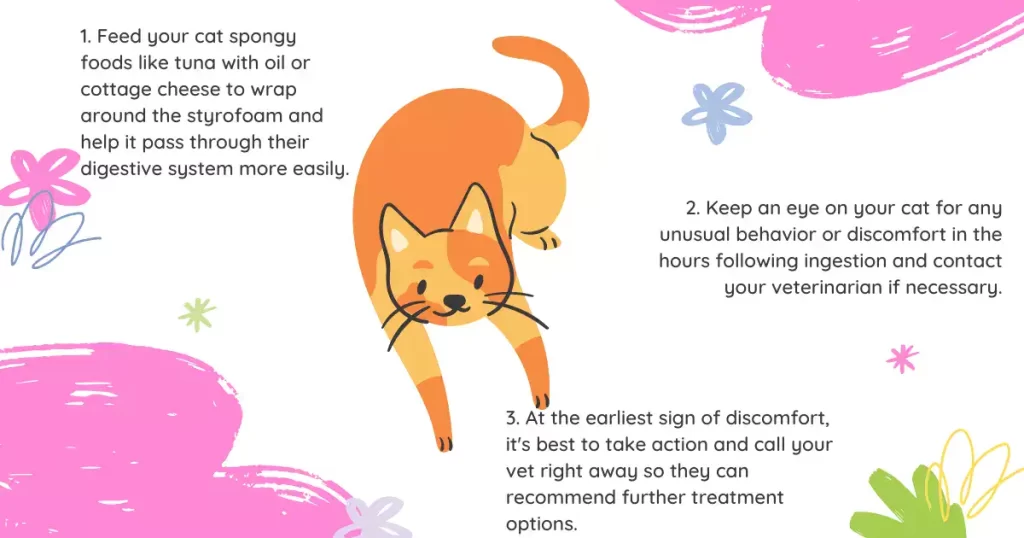
Is There a Risk of My Cat Getting an Intestinal Blockage If They Ate Styrofoam?
Yes, there is a risk of your cat getting an intestinal blockage if they ate Styrofoam. The material can stick to the internal walls of the digestive system and cause a blockage. If the blockage is partial, it can lead to vomiting or diarrhea. However, when it’s a complete intestinal blockage, it can cause constipation.
If the food doesn’t manage to pass through the intestines, it will rot inside it, causing bad bacteria to prosper and spread through the organs. This can lead to ruptures or death of part of the stomach or intestines, resulting in life-threatening complications for your cat if not treated promptly.
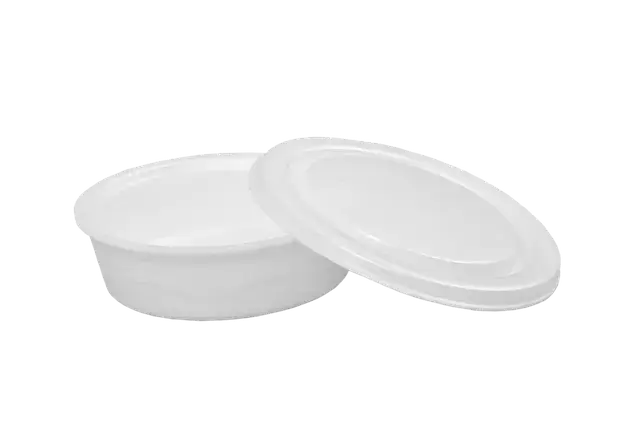
Additionally, some types of styrofoam may contain chemicals that could irritate your cat’s mouth or digestive tract causing him to salivate excessively or even vomit in large quantities. However, this is unlikely as cats don’t typically eat enough styrofoam for this effect to occur.
How Long Does It Take to Pass a Blockage?
It can take anywhere from 10–24 hours for a blockage caused by Styrofoam to be passed in the feces, but it could take much longer than this. The larger pieces of Styrofoam are unable to fit through the narrower points such as the small intestine, which can lead to intestinal obstruction.
This is life-threatening if left untreated and symptoms include vomiting (usually multiple times), struggling to keep down food and water, constipation (or diarrhea), not wanting to eat, and lethargy.
How Can I Tell If My Cat Is Having Difficulty Digesting the Styrofoam?
1. Watch your cat for signs of vomiting or diarrhea. If they begin to show either of these symptoms, contact your veterinarian immediately.
2. Observe your cat’s behavior and look for any changes in activity level or vocalization patterns that may indicate a digestive issue.
3. Monitor their food and water intake to see if they’re eating less than usual or not drinking enough water with their food intake decreasing significantly over time (this can indicate a blockage).
4. If you notice any of these signs, take them to the vet as soon as possible since digestive blockages are life-threatening and require immediate medical attention from a professional vet.
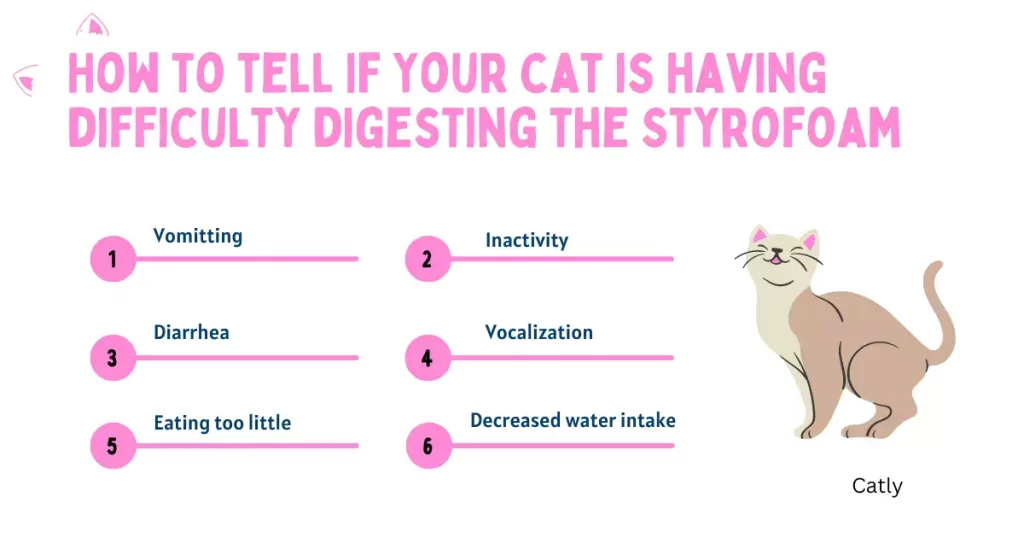
What Advice Would a Veterinarian Give If My Cat Ate a Small Piece of Styrofoam?
1. Determine if there is any remaining Styrofoam that your cat has ingested. If so, drop it in water to see if it dissolves or not. This confirms two things. If it dissolves, it is degradable but if it doesn’t then it is not degradable.
2. Feed your cat spongy food like tuna with oil or cottage cheese to help wrap around the styrofoam and help it pass through their digestive system more easily.
3. Watch your cat for any unusual behavior or discomfort in the hours following ingestion of the styrofoam piece(s). If there is any adverse effects, you need to rush to the vet immediately.
4 If no signs of discomfort are seen after 48 hours have passed since ingestion, they should be fine and no further action needs to be taken at this time.
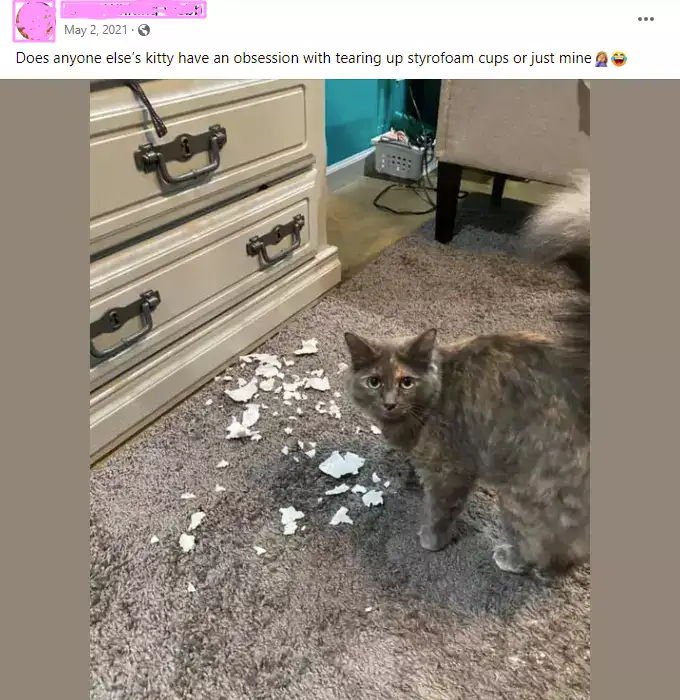
Why Is My Cat Eating Styrofoam?
Biting and using their claws are two major needs of cats that styrofoam fulfills. Cats can use their claws to sharpen them on the foam and bite it for fun or playtime. Furthermore, eating styrofoam satisfies their hunger since they associate it with food packaging.
Now that we are talking about weird things that cats eat, have you ever wondered why cats feast on flies? Well, I’ve packaged an interesting post on why cats eat flies and the benefits.


